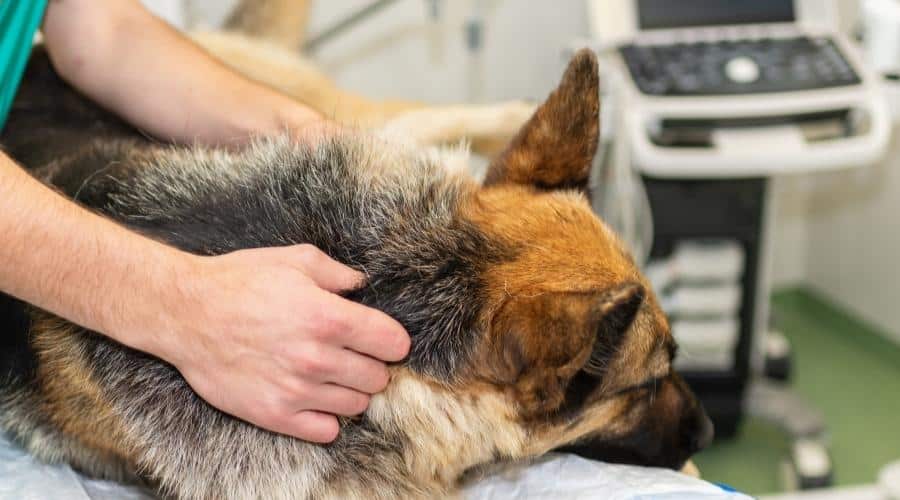German Shepherd Prices: How Much Do German Shepherds Cost?
When you purchase through links on our site, we may earn a commission. Here’s how it works.
This guide discusses the average expenses of owning a German Shepherd from puppyhood through senior years. German Shepherds are a very noble breed, known for their intelligence, loyalty, and bravery. This breed has long been used as herding and working dogs. These lovable dogs make wonderful pets but might not fit with every family due to their generous size. As with any other breed, adopting and raising a German Shepherd dog (aka GSD) means taking on the cost and responsibility of caring for your dog throughout its life and keeping them healthy throughout all life stages.
Table of Contents
Dogs are always a significant investment and financial commitment, and some breeds will cost far more than others, depending on breed and pedigree. German Shepherds are a breed that comes with a few unique needs than some smaller breeds. Care and feeding are part of it. However, large breeds like these can have more needs than just the basics.
In this guide, we break down the costs of adopting and raising a German Shepherd. We will present expected costs like adoption fees, medical care, feeding, supplies, etc., and some breed-specific costs like training and grooming. Let’s get into the details about German Shepherd prices.
What Does A German Shepherd Puppy Cost?
The initial investment into a high-quality, healthy purebred puppy can cost anywhere from $800 to over $4,500 for champion or show pedigree bloodlines. The average German Shepherd pup will cost about $2,000. Bloodline, location, time of year, and age all impact price. Puppies purchased from breeders will be more expensive than those adopted from rescues and shelters. Mixed-breed pups can cost less or more depending on the other breed that a German Shepherd is mixed with.
How To Calculate German Shepherd Costs
It is essential to keep in mind that every dog and family situation is different. This guide presents an average minimum price for owners to expect. Because we cannot yet predict the future, it is essential to point out that there may be some unexpected or unplanned costs that arise. This is a normal part of pet ownership and something everyone looking to bring an animal into their lives needs to understand. We have worked hard to provide you with an accurate and realistic expectation of what kind of financial responsibility is expected when raising a German Shepherd.
Expenses over the first year will include the initial cost of the puppy, as well as supplies. Owners will need beds, food bowls, crates, toys, treats, and more. Medical expenses will increase over the first year as puppies need vaccination, several checkups, and a spay or neuter procedure. Supplies to get started can cost anywhere from $500 to $1,000. Expect an initial investment of at least $3,000. This does not include training, walking, boarding, or any medical care. Expect more medical costs in the first year. Those costs of vaccinations, spaying/neutering, flea, heartworm prevention, etc., cost, on average, about $1,200. So, expect about $3.000 to $4,000 in the first year.
GSDs live about 10-13 years. They can cost anywhere from $100 to $300 a month to feed and care for, about $3.000 a year. Plus, with an initial investment of $3,000, owners can expect to spend a minimum of $40,000 to $50,000 for the lifetime cost of raising a German Shepherd. Keep in mind this is an estimate, not an exact prediction.
| Average Cost Of German Shepherds | |
|---|---|
| Initial Puppy Price & Supplies | $3,000 |
| Yearly Costs | $3,000 |

Whether or not a puppy is purebred makes a significant difference in price. Bloodline, color, age, location, size of litter, and breeder expenses all come into play. Champion and prize-winning bloodlines will be significantly more. Additionally, the purpose of the canine, from pet, service, show, to work, etc., can make a difference as well.
Factors That Affect Price
Several factors affect the price of canines. These include health, age, size, bloodline, health, litter size, and location.
Health
The health of the puppy and pre-screening for disease can also impact the price. Breeders who screen will ask for more, which will be reflected in the price. Reliable breeders will provide documentation of all health screenings. The amount of investment a breeder has made into a puppy will be included in the price.
Age
The age of a puppy plays a big part in the price. Younger puppies, those about 8 to 12 weeks old, are the most expensive. This is in part because most people want young puppies. There is an extremely high demand for this age group. Older dogs and adult dogs will be less to adopt as many people prefer younger dogs. Older dogs are harder to rehome, and senior dogs often have health issues. This can often mean they will cost less to adopt but may have more medical needs as well as different nutritional needs than younger pups.
Size
The size of a pooch can mean a different price tag. This goes for both smaller and larger pups. Prices can fluctuate, and folks looking for larger dogs will need to expect to pay more. However, the bloodlines of smaller pups still make a massive impact.
Litter Size
Litter size is a factor in how much a German Shepherd pup costs. The more puppies in a single litter, the lower the price tag. Litters with three or four pups are preferable. How many litters a mother dog has will also impact how much a puppy will cost.
Location
Where someone is in the world will make a stark difference in how much a puppy will cost. Every region has slightly different price points, and puppy price tags will vary by region. Some travel may need to happen to transport a pup like this home.
Health Screening & Breeder
Reputable breeders will provide health screening information. This will add to the tab but helps keep canines healthy as long as possible. High-quality breeders charge more. This is an excellent place to invest as these breeders raise healthier dogs. Reputable breeders are always happy to answer questions and show proof of what diseases and conditions a dog has been screened for.
Purpose
The purpose of a puppy also has a big part in the price tag. Show dogs always cost much more. Companion animals are less, and service and working dogs will have higher price tags. This is because these pups often need special training or have been bred from select bloodlines.
Bloodline
Bloodline and pedigree are among the most significant factors, along with age, in the price of a puppy. Purebred dogs are the most expensive and the most in demand. Mixed breed pups are less expensive to adopt, much less, and, in many cases, can be healthier than purebred parents.
5 Types Of German Shepherd Lines

1. American & Canadian Show Line
This line is often seen in America and Canada and is the line most often seen as show dogs in these places. This line has smaller heads, and thin legs, and the back legs are shorter than the front. Additionally, they come in several colors, often a solid coat with some two-color combos. These include solid white, black, saddle sable, and black and tan saddles. This line is less suited to work and was developed for its looks. These pups run between $1,500 and $3,000.
2. DDR/East German Working Line
The Deutsches Demokratische Republik (DDR) German Shepherd is a dog with an interesting origin. They were developed under the close watch of the East German government during the Cold War. They were bred explicitly to be loyal, hardworking dogs that could withstand harsh temperatures and were skilled at work with the military and police forces.
This breed was used to guard the borders between the two countries. They were bred for large bodies, large heads, and sleek dark-colored coats. When East and West Germany united, the bloodline was almost lost, as demand decreased rapidly for these canines. They are found occasionally as pets. This is not a good choice for new or inexperienced owners. These pups have a significantly higher price tag, about $2,500 to over $3,000.
3. Czech Working Line
This line was a continuation of the DDR/East German Shepherd. These dogs are agreeable, loyal, and extremely obedient. They were bred as guard dogs and are exceedingly rare to find. They have a high price tag, between $2,500 and $3,000 on the low end.
4. West German Show Line
The West German Show line is bred to meet the breed standard exactly. They are rare as pets and have an intimidating price tag, between $5,000 and $8,000.
5. West German Working Line
The West German Working line is a line developed to work, be sturdy, and be obedient. This line is often used as working dogs for the military and police but does make beautiful pets. They have a price of about $1,500 to $3,000. This line is often used in entertainment and is remarkably close to the original breed of German Shepherd.
Costs For German Shepherd

These pups reach between 50 to 90 pounds, which means they will need large to extra-large supplies. These often are much more pricey than smaller toys, beds, collars, harnesses, leashes, etc. Any pup will need at least $1,500 a year to support.
We have done some research to estimate the expenses owners can expect to cover when adopting a German Shepherd. Keep in mind that this is an estimate. Prices will vary by location and for every individual pup.
A good portion of supplies will need to be replaced often, like food, collars, toys, beds, crates, etc. Licensing fees, microchipping, and local fees will vary. Every dog will need basic care, feeding, and veterinary visits. We have a general estimate of what caring for a German Shepherd will cost per month.
| Supplies | Average Cost Per Month |
|---|---|
| Food | $65 |
| Medical Care & Medications | $50 |
| Emergency Care | $25 |
| Pet Insurance | $50 |
| Grooming | $50 |
| Grooming Supplies | $25 |
| Dental Care | $10 |
| Nail Clipping | $20 |
| Toys | $20 |
| Treats | $15 |
| Cleaning Supplies | $10 |
| Total | $365 |
Food
Food is an expense that will always be present and may fluctuate as a dog ages. Puppy food is needed for about the first year, and this may be a higher price tag. German Shepherds are a bigger breed, so they need large breed-formulated food. Higher quality foods are more expensive. Puppies will eat less food at first, but a growing adolescent dog may seem to have an insatiable hunger. On average, a 30-pound bag of dog food costs about $50. Owners should count on spending at least $50 to $100 or more a month to feed their pup.
Basic Medical Care & Medications
Some pups will need medications, supplements, etc. This breed is known to be anxious and may need calming supplements. They also are prone to allergies. Owners should factor in about $25 to $50 a month for medical care. While this may not be true every month, planning on it helps owners be prepared to offset expenses if they come up.
Emergency Medical Care
Emergency medical care is quite expensive, and pet owners should be aware of this. No matter how well a pet is cared for, medical emergencies happen. Of course, owners never want their dogs to need this kind of treatment, but it is advisable to be prepared for it. Setting aside a little money every month, even just $25, is an excellent idea to help offset these emergency care bills when they arise. It is emotionally and financially devastating when owners find out their beloved Fifi needs emergency care and the price tag is high.
In some cases, emergency costs can go over the $1,000 mark. So, budget a bit every month to help, just in case. This breed is prone to health conditions, including hip dysplasia, bleeding disorders, heart disease, degenerative myelopathy, epilepsy, eye issues, immune-related diseases, Hemangiosarcoma, and exocrine pancreatic insufficiency.
Pet Insurance
Pet insurance may be something owners want to investigate for a German Shepherd. While this is not a necessity, it is something that is of great benefit to owners when emergencies happen. Insurance can also offset the cost of regular care. There are a variety of options for pet insurance. Plans include emergency care, wellness plans, and more. Some major providers offer pet plans, and there are several stand-alone choices. The monthly cost will vary depending on the breed. Prices range anywhere from $10 a month to over $200. Older canines will cost more, and most plans have a deductible. Research companies to find the best plan for you and your pet’s needs.
Grooming
Grooming is something that most dogs will need at least every few months. GSDs are big shedders with higher grooming needs than some breeds. They need to be brushed a minimum of three times a week. During high shed periods, they will need brushing every day. Grooming tools for the home are needed, and professional grooming once every 2 to 3 months. Grooming can range from around $10 a month to over $100 for professional grooming. Longer-haired pups will need to be groomed more frequently than short-haired dogs.
Dental Care & Nail Clipping
Another part of grooming that owners need to be aware of is dental care and nail clipping. Dental care is often very expensive, especially if it is not done often. Owners should clean their dog’s teeth at least three times a week. Daily is best. A professional cleaning from the vet can be pricey but may be necessary once a year. The cost can range from $100 to over $700. Basic cleaning is about $100. Some pups will need anesthesia which costs about $75 to $100 or more. There will be additional fees for examination and any kind of dental treatment required.
Nail clipping should be done about once every three weeks. Owners can do this. However, with big breeds like this, many owners opt to have it done at the groomer or vet. This service usually averages between $10 and $25.
Other Supplies
There are other supplies that dogs and puppies will need, including puppy pads, poop bags, pooper scoopers, beds, treats, cleaning supplies, toys, leashes, harnesses, collars, and other regular needs that need to be replenished. Expect about $25 a month for these. Keep in mind that these are larger dogs, and these supplies are more expensive in large and extra-large sizes.
Additional Costs

Additional costs include training, dog walking, doggie daycare, boarding, and supplements. These costs will vary depending on the specific dog and living situation. Some owners will be able to afford more than others. Some owners will invest in doggie monitors, dog spa days, and other entertainment options. This all depends on what an owner can afford and what each specific dog needs.
Professional Training
Professional training is something many owners invest in by choice, and plenty of others will find it necessary. Price tags of professional training vary by the trainer and by need. About $50 an hour is a good average to expect. Pet stores, veterinarians, and dog boarding facilities offer obedience classes and training sessions. Specialized training like tricks, show training, protection, and service dog training will be much more, about $80 to $100 per hour or more. Online training is an affordable option for owners who can put in the time and have the patience to try training without the trainer there personally.
Walking
Dog walking is essential, especially for a larger breed like the GSD. The cost of this will vary depending on the number of walks, length, and whether the dog is walked alone or with other dogs. There are local options and national companies like Rover and Wag that offer individual walks and monthly packages. These range from $10 to $20 an hour or by the walk or package.
Boarding, Dog Sitter & Daycare
Boarding and daycare are usually optional. For some owners, they may be necessary. Some pups will have separation anxiety and will not want to be alone. Owners who travel a lot will need to invest in a sitter or boarding facility. These can be costly, costing at least $50 daily for basic packages. Daycare will range from $10 an hour to over $100 a day, and again owners have assorted options to choose from. This can vary by location and level of care needed.
Frequently Asked Questions
Are German Shepherds expensive?
They can be a higher-priced breed, but not always. The price can be extremely high or moderate, depending on the dog’s bloodline, age, and breeder. Generally speaking, this breed will be more expensive than many others to adopt and care for. Owners not ready for a big financial commitment may want to consider a different breed.
Why are German Shepherds more expensive than some other breeds?
German Shepherds are more expensive because they are larger breeds and because of their bloodlines. Purebreds are always more expensive than mixed breeds unless they are a designer or specialty mix.
Can I adopt a German Shepherd from a shelter?
This breed can be found in shelters, though it is rare (but not impossible) to find a purebred puppy in a shelter. Older dogs, especially retired working dogs, will often be found in shelters and rescues. The National Animal Humane Society and The American German Shepherd Rescue Association (AGSRA) are good places to look. Additionally, veterinarians and trainers are excellent places to ask for referrals.
Final Thoughts
The expenses involved in adopting and raising a German Shepherd are higher than many other breeds. This is due to the breed’s pedigree, size, and availability. Not every dog of this breed will be so expensive. However, owners should not expect this to be a budget-friendly dog. They can be found for less money through shelters or rescues, but there are not many purebreds available in these situations. Our guide focused on adopting and raising a purebred German Shepherd as a pet. We estimate that a German Shepherd can have a price tag of around $40,000 to $50,000 to raise over a lifetime.
Remember that our estimate is just that and does not include special needs or training an animal may have. Dog ownership is a big responsibility. Owners need to know that there are far more costs than just adopting and feeding a pup. There will be times when, especially with a larger breed, expenses can add up to a remarkably high number. There is no way to put a number on the amount of love, happiness, and joy a dog brings into one’s life. Before adopting any canine breed, prospective owners should research and learn the monetary needs associated with raising them. Those who have the time, money, and energy to keep up with this iconic breed will never question the wealth that comes with having a four-legged best friend.



